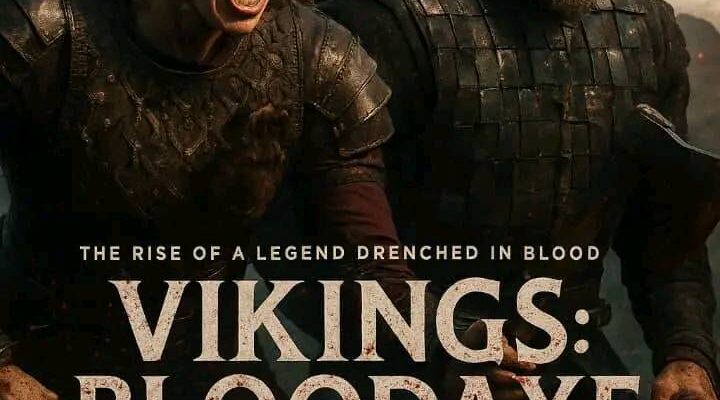“Netflix Unleashes ‘Vikings: Bloodaxe’: A Brutal Saga of War, Betrayal, and Revenge Where Gods Demand Blood from the Fierceborn”
Netflix has once again captured the attention of history and drama enthusiasts with its latest release, Vikings: Bloodaxe. Promising a visceral journey into the brutal and unforgiving world of Norse warriors, the series plunges viewers into a realm where loyalty is fleeting, betrayal is deadly, and the gods themselves demand blood from those destined for greatness. From the very first frame, it becomes clear that this is not a retelling of the past for mere entertainment—it is an immersive experience designed to make audiences feel the weight of every battle, the sting of every betrayal, and the ferocity of revenge that drives its characters forward.
At the heart of the story is the central figure, a man born amidst chaos and conflict, a warrior forged in the crucible of endless battles. Known only as Bloodaxe, he is a figure of mythic proportions, embodying both the physical prowess and moral complexity that made Vikings legends in history. The show does not shy away from the stark realities of Viking life. It depicts their world as raw and unrelenting: a society where strength, cunning, and honor are measured not by words, but by actions on the battlefield and decisions made in the shadows of political intrigue. Bloodaxe’s journey begins with survival and quickly evolves into a relentless pursuit of power, as he navigates a landscape filled with enemies, allies, and gods whose demands are as merciless as the warriors themselves.
What sets Vikings: Bloodaxe apart from other historical dramas is its dedication to authenticity, both in setting and storytelling. The creators have painstakingly recreated the harsh environments of the Scandinavian wilderness and the intricate, wooden fortresses that once dotted the landscape. Every battle sequence is meticulously choreographed, capturing the brutal reality of combat during the Viking Age. The sound design is equally immersive, with the clash of swords, the roar of warriors, and the omnipresent howl of the wind creating a sensory experience that draws viewers directly into the thick of conflict. Costume and set design further enhance the realism, showcasing the detailed craftsmanship of Viking armor, weapons, and domestic life, all while reflecting the social hierarchies and cultural norms of the time.
But beyond the physicality of the series, it is the emotional depth and moral ambiguity of its characters that truly captivate. Bloodaxe is not a simple hero or villain; he is a man shaped by circumstance, torn between ambition, loyalty, and the inevitable cost of violence. As he rises in prominence, he faces ethical dilemmas that challenge not only his survival but also his very humanity. His relationships—fraught with love, rivalry, and betrayal—highlight the complex social dynamics of Viking society, where alliances are often temporary, and trust can be a dangerous gamble. The series delves into these personal struggles with an intensity that elevates it beyond a mere action-driven saga, making viewers ponder the true nature of honor, vengeance, and destiny.
The spiritual dimension of Vikings: Bloodaxe also plays a critical role. The Norse gods are not distant mythological figures; they are active participants in the lives of mortals, their influence shaping events in mysterious and often terrifying ways. Bloodaxe’s encounters with the divine add a layer of mythic grandeur to the story, underscoring the tension between human agency and fate. Scenes where gods demand blood or deliver omens are both visually stunning and narratively compelling, blending historical fiction with mythological fantasy in a manner that feels both grounded and epic. The series explores the interplay between mortal ambition and divine will, posing questions about destiny, sacrifice, and the price of power that resonate with contemporary audiences despite the historical setting.
Character development in Vikings: Bloodaxe extends beyond the protagonist. Supporting characters are richly drawn, each with their own motivations, flaws, and arcs. Allies can turn into enemies, and minor players can shift the course of the story with a single decision. This intricate web of relationships enhances the unpredictability of the series, keeping viewers constantly engaged as the stakes escalate. The political intrigue, combined with brutal warfare, creates a narrative rhythm that balances cerebral strategy with visceral spectacle. The series rewards attentive viewers who are willing to track the shifting loyalties and hidden agendas that define Viking leadership and society.
In addition to its narrative strengths, the show’s pacing and cinematography are particularly noteworthy. Sweeping shots of icy fjords, storm-lashed seas, and dense forests establish a sense of place that is both beautiful and menacing, reflecting the harsh realities of survival in the Viking era. The editing ensures that action sequences are intense and coherent, allowing viewers to follow complex battles without losing sight of character motivations. Music and soundscapes further amplify the emotional resonance of each scene, from the eerie quiet before a raid to the thunderous crescendo of combat. This attention to audiovisual detail ensures that every episode is not just watched, but felt.
Netflix’s commitment to producing a series that appeals to both history enthusiasts and drama lovers is evident in every aspect of Vikings: Bloodaxe. The storytelling is layered, combining political machinations, personal vendettas, and spiritual undertones, while maintaining the high-octane energy expected from a Viking epic. The series challenges viewers to consider the cost of ambition, the inevitability of conflict, and the thin line between heroism and brutality. It is a tale of survival, strategy, and revenge, crafted to resonate with contemporary sensibilities while remaining rooted in the harsh realities of a bygone era.
Ultimately, Vikings: Bloodaxe is more than just a historical drama; it is a study of power, morality, and human resilience. By placing a legendary warrior at the center of a world ruled by violence and divine expectation, Netflix has created a series that is both intellectually engaging and emotionally compelling. It invites viewers to witness the rise of a figure destined for greatness while confronting the moral and existential challenges that come with such a destiny. The show’s combination of historical authenticity, mythological depth, and cinematic spectacle ensures that it will not only attract a dedicated audience but also leave a lasting impression on those who experience it.
From the very first episode, it is clear that Vikings: Bloodaxe is designed to captivate, shock, and move viewers. With its relentless storytelling, complex characters, and stunning production values, it stands as a testament to the enduring appeal of Viking narratives and the skill of modern television in bringing them to life. The gods demand blood, and Bloodaxe is ready to pay the price—but viewers, too, will be compelled to follow every twist, turn, and clash of swords in this unforgettable saga.



